
The
Midland Grand Hotel, St Pancras Railway Station (Now St Pancras International), The British Library,
The British Museum
and a Historical Walk in London
At
"www.England-Central.co.uk"
we continue to encourage you to walk in London and find the detail of
how the city has developed. This is an interesting walk in the
northern part of the city but still within the inner tourist and
visitor section. You are unlikely to have any trouble and can feel
safe to walk. Hotels are smaller but pleasing to visit. You can if
you wish, start at the bottom of this article and work your way north
to finish at St. Pancras Station .
THE WALK
:
The Northern part of the city of London has a string of
Victorian rail termini, King's Cross, St. Pancras, Paddington and the
rebuilt Euston Stations. On arrival at St. Pancras, the people spill
out of the trains, and if they choose to look up find a vast steel
span and a grand Victorian edifice. A huge steel span between
Neo-Gothic arches of red and cream brick and stone defines this
Victorian style, now blended with the modern (2007) refurbishment.
In 1863 the Midland Railway secured an Act of
Parliament to build a new terminus on a site adjacent to King's Cross
Station. It was designed by W.H. Barlow (1812-1902),
Engineer-in-Chief to the Midland Railway. For the train shed he
created an engineering wonder - the largest enclosed space that had
been erected in the world: height of the arch above rail level 105
feet, length 690 feet, and the single span width 240 feet.
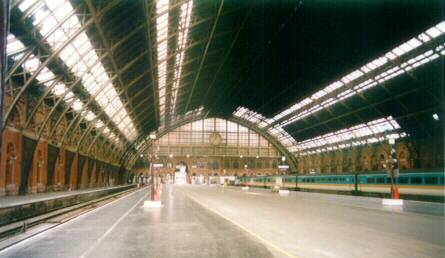
Late in 1865 a competition was held to design the
station hotel with around 150 beds. Of eleven architects, Sir George
Gilbert Scott (1811-1878) submitted a grand plan considerably larger
than the original specification, with more than 300
bedrooms.
Financial problems caused delays in building the
hotel and the eastern wing of the building was not opened until 5 May
1873, with the rest opening in Spring 1876. The hotel fabric had cost
£304,335, decoration and fittings £49,000 furnishings
£84,000 - a total of £437,335. Gillow (later Waring and
Gillow) were closely involved in providing furniture and furnishings.
The completed building had used 60 million bricks and 9,000 tons of
ironwork. The polished columns of fourteen different British granites
and limestone’s are frequently mistaken for marble.
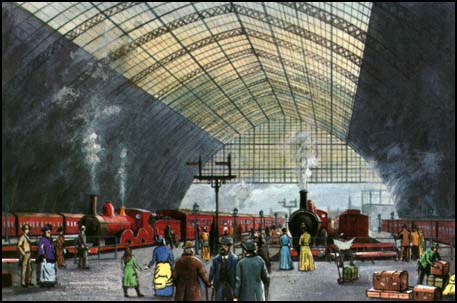
In its heyday, the Midland Grand Hotel was one of
the most opulent in London. with over 300 bedrooms. However the hotel
closed in 1935; its facilities were outdated and it was too expensive
to run and refurbish. It was then used as railway offices and renamed
St Pancras Chambers. In the 1960s the building was saved from
demolition and given Grade 1 listed status in recognition of its
importance as a great example of high Victorian Gothic architecture.
In the 1980s the building failed its fire certificate, it was closed
down and has remained empty.
In the 1990s the exterior of the building was
restored to its original condition, and made structurally sound and
weatherproof. The work was finished in March 1995 and cost around
£10 million.
Whilst the interior of the building was in a poor
state of repair, much of the original decoration, including
stencilling, mosaics and ornamental ceiling, survive behind more
recent decoration and alterations. This is all now much improved with the 2007
refurbishment.
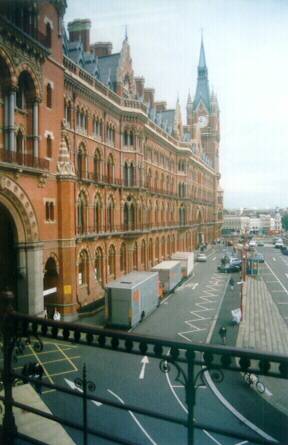 .
.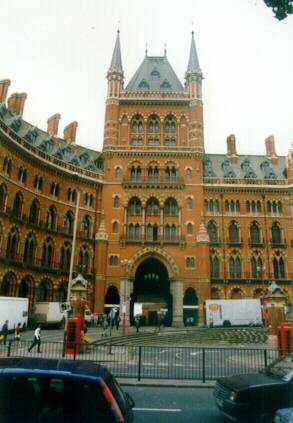 ..
.. ..
..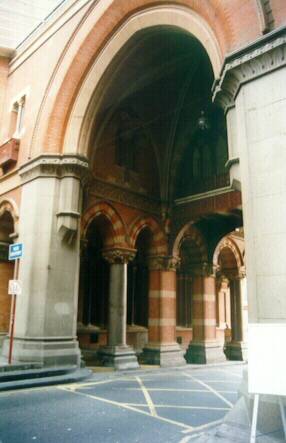
The old booking hall was cluttered by modern signs and the wood
pannelled ticket office providing a way out on to the wide expanse of
Euston Road. Walk down Midland Road for a few meters and look up.
St.Pancras Station is fronted by the glory of the old Midland Grand
Hotel. Its external appearance mimics the station, a Neo-Gothic pile
of pinnacles and slates. It no longer serves as a hotel and provides
architecture without service. From the Midland Road it climbs out of
the street to the sky and runs down to the "catacombs" and archway
services. From heaven to earth in a single street.
The British
Library
The British Library defies the Victorian structure across the
road. Red and black and steel overhangs, peering at its Victorian
Gothic predecessor - transport clothed by the old idiom sits next to
the new idiom encasing the old treasures.
Walk through the British Library grills and enter the modern
"castle". The brick and stone and forecourt provides shelter from the
traffic. The library itself has a brash modern exterior which climbs
up to the slate roof. Inside, the marble and brick tiles at the open
entrance lead beyond to 1000 years of British and world history in
print and calligraphy and map.
On a practical level, it is a good place for a
cultured bite - eat and see the
history before your eyes - the cafe is hidden beyond the great tower
of books.
COMMENT:
It is a place to meet, a place to be, but does it really take the
mind to the book : does it really promote scholarship and study and
an entering of the world of the past.
A place with too much empty space , it perhaps feels more like
entering the foyer of a railway station, or perhaps it is the
architects joke on us.........visit it and see.
RETURNING TO EUSTON ROAD, TURN LEFT OUT OF THE
LIBRARY AND WALK WEST....HOTELS NEARBY.
Hotels : Bloomsbury
You can select Hotels from our hotel site. Just select London and the
Bloomsbury district.

Some Victorian
London
Get away from the blast of the traffic and
duck down behind St.Pancras Parish Church and on to "Woburn
Walk"...you are in victorian London of bookshops and silver and the
street cafe.
Emerge on to "Woburn Place" and head south past uninteresting modern
flat faced buildings., skirting two London Squares. "Russell Square",
the second, is part of Georgian Bloomsbury. Note the facade of the
Russell Hotel in its Victorian balconied spendour. Enter Beford Place at the
south of Russell Square.
British
Museum
Turning right at the bottom of "Bedford Place" skirt "Bloomsbury
Square" and enter "Great Russell Street". The most notable building
to the right after a few metres is THE BRITISH MUSEUM, with its
Neo-Classical spendour. Pass through the ornate cast iron railings
and not the detail and the pairs of columns which face the
museum.
Of great interest now is the new piazza (The Great Court) and
refurbishment of the Library used by many famous figures including
Marx and Lenin.
Within the Library a new collection of books is being build up
supported by the Paul Hamlyn Foundation. These new modifications were
opened in Dec 2000 for the new millennium.
On the floor of The Great Court is the quotation :
"and let thy feet, millennia hence, be set in the midst of
knowledge" :
Tennyson :
a fitting quotation for the refurbishments for the start of the
new millennium.
The piazza is covered by triangular ceiling panels providing
amazing light be reflection from the white stone walls and floor.
Again it is possible to eat and get refreshment and do not miss
entering the old part of the museum via the "bird hole"..climb up the
spiral staircase.
Advertising: please
e-mail using the information to the left.
Back
© Kogan Communications
Ltd. 2008



 .
. ..
.. ..
..